

Luggage Wear
Setsumasa Kobayashi
from .....RESEARCH
2019.08.29


VOL.12
Find out little-known yet interesting facts about clothing through the words of discerning designers who have been creating
essential masterpieces for BEAMS PLUS collections.
The crucial new philosophy of BEAMS PLUS,
“Updating timeless classics for the future,” cannot be achieved without their wealth of knowledge.
vol.12
Luggage Wear
Setsumasa Kobayashi
from .....RESEARCH

Setsumasa Kobayashi (Representative of .....RESEARCH)Kobayashi was born in Tokyo in 1961 and worked with numerous brands as a freelance shoe designer before launching his own brand GENERAL RESEARCH in 1994. In 2006, he began to present his products on a particular theme as a part of the .....RESEARCH project. Each item for the project is designed based on the careful researches on existing products related to each theme. MOUNTAIN RESEARCH is the core of the project, offering goods and clothes made as a result of field tests he did while living on a mountain.
My personal definition of luggage
wear is
something rather
emotional than functional.

America’s mass-produced
casual clothes are
filled with
practical ideas to be commercialized.
For me, luggage wear means clothes designed to allow the wearer to carry a lot of things at once with the large-capacity pockets while walking. It doesn’t matter which type of clothes it belongs to. A game vest is, for example, initially made to carry animals during a hunting activity. I regard the item as one of the original designs of luggage wear. Military uniforms are also made to be used with occupied hands just like hunting clothes, so they have to be functional enough to carry things as luggage wear. This type of clothes began to be commercialized around the 1940s. It was the time when made-to-order clothes got less popular and ready-to-wear products, especially sportswear, became widely produced. I guess that is why the range of such functional clothes got enlarged around the 1950s.


When all the clothes were made to order, the most important thing in designing was probably to make each item look stylish or beautiful with a designer having all the responsibility for embodying his/her idea in it. In the 1950s, however, functional clothes including hunting and military wear became commercialized as the era of mass production began. And that is why various practical features, such as pockets for tools or bullets, were added to clothes. Because the U.S. did not suffer from World War 2, a lot of hobby-related clothes had been developed around that time, while sport-casual styles got largely popular in the country.

Though there are so many types of game vests made for hunting use, such cropped models seem most practical because they are designed to allow the wearers to walk properly with equipment stored in the pockets. It’s a very American, daring design of clothing. Another interesting example of luggage wear is a survival vest which was developed after World War 2, around the time when the Korean War and the Vietnam War broke out. This one is called a C-1 vest and was designed to carry various tools in the pockets. Each pocket is uniquely made to store particular equipment, while the size is determined according to the content. You can see that each of them has a stencil on its surface or flap, so that soldiers can understand what it contains. Such in-depth detailing tells us that the item is rigidly designed. It’s really interesting.

There is an almost-faded stencil on the flap for instruction.


Most of L.L.Bean’s hunting jackets in Kobayashi’s personal collection are from the 1960s and 1970s.
I don’t know whether this pocket design is patented, but it’s definitely my favorite. Many hunting jackets made by L.L.Bean in probably the 1970s feature it. Each of the top and bottom pockets is separated by an inside divider panel placed in the middle, while one of them can also be used as a flap of a pocket below it. And the overall shape of the pocket is just incredible. Regarding hunting and military vests, almost all the pocket designs had been completed around that time in the technical aspects. After the invention of velcro and plastic fasteners, however, the design of the flap-closure was updated a few times, I think. While the details of military uniforms can be totally and mandatorily changed for some reason, it isn’t so easy when it comes to hunting vests because the item is usually worn by an independent hunter who spends time alone in the woods. Each piece has to come with unique features to meet unique requests from them, while being reliable enough. I guess that is why lightweight but relatively weak plastic parts hadn’t been used for hunting vests for a while.



Kobayashi’s atelier is filled with a huge collection of hunting and fishing vests.

I don’t know where I’m going,
but I buy all of the items as long as
it has interesting pockets.
I don’t collect those as luggage wear because I basically prefer things made after the 1950s as they look more casual. Most interesting part of the clothes is, for me, the pocket design, including how it looks, where it is placed and how the flap is attached. I’ve been collecting them for such a long time, but I still don’t know where I’m going. I buy all of them as long as it has interesting pockets (laughs). And the result is this huge collection of hunting, military and fishing vests. I still buy it sometimes. My collection is full of weird stuff, but a few rare items. I think, however, there must be many pocket designs I’ve never seen before in this world. We can now easily find functional clothes that can store a lot of belongings in the pockets at travel goods stores, but my personal definition of luggage wear is slightly more emotional and different from such modern ones. I’m not interested in highly function-oriented designs. I created my exclusive items for BEAMS+ (BEAMS PLUS) by combining a series of ideas I mentioned before and vintage luggage wear designs.
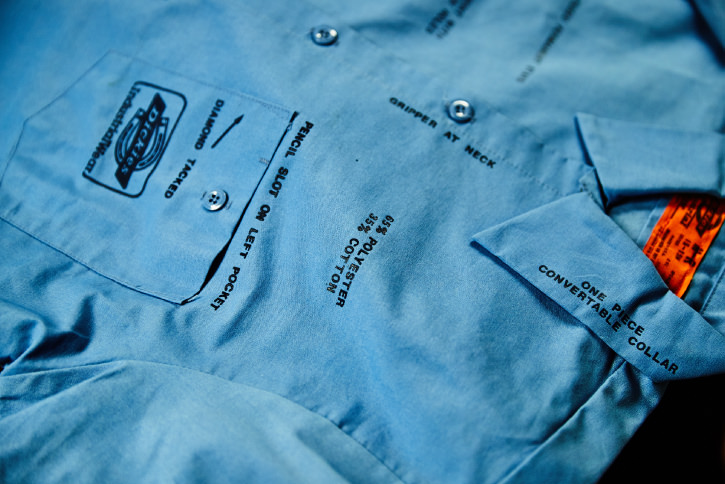
A salesman’s sample with written selling points printed on each detail.
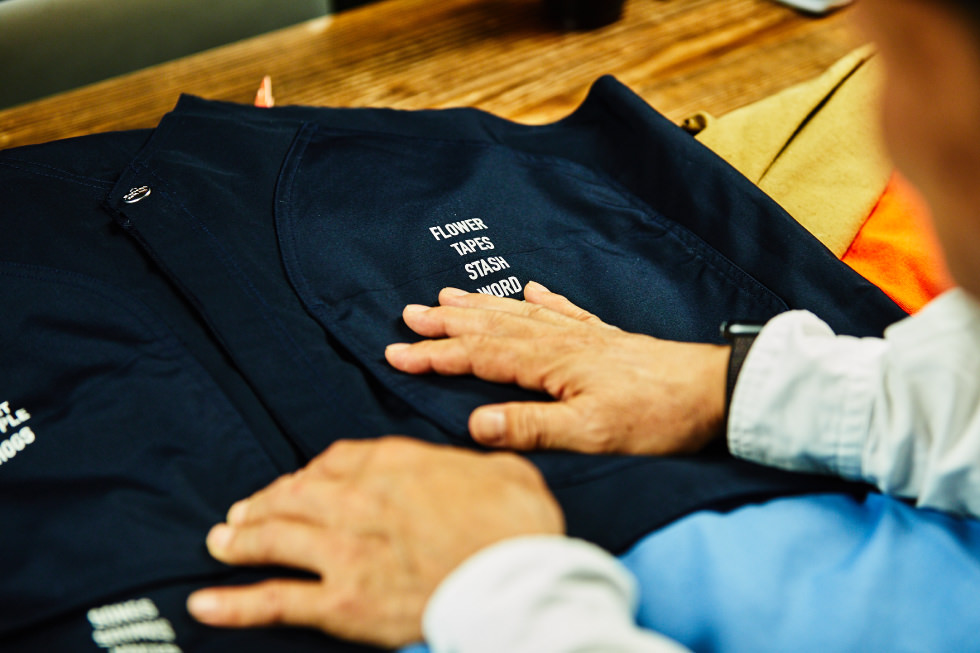
The original inspiration of the design came from the stencils on C-1 vests. Making a garment with the detail not for battlefields means that we can freely decide what each pocket should contain, doesn’t it? Designers usually express their messages through their designs, but this detail gives me one more fussy way of expression. I enjoy annoying people by whispering “wouldn’t it be nice if you put a flower here?” or “How about stowing your lip balm in this pocket?” with the prints (laughs). I even picked a word used in a song by the Grateful Dead. The design also conveys my thoughts that a pocket should contain various things. The shape of each pocket is made by referring and converting my favorite designs. Another inspiration of my design is salesman’s samples. American salesmen used to use them to learn about their products. This shirt, for example, has selling points printed on the body. The detail intrigues me, too.

The design of this shirt is also referred from hunting wear, based on a shirt with large gusset pockets surrounding the waist. It was made by RED HEAD probably in the 1970s. The one I own has no sleeve, so I exercised my imagination to develop a story of what if the shirt came with detachable sleeves with buttons. Because of the durability and frequency of use, shirts are less findable than jackets in the vintage clothing market. Similar shirts can be found sometimes, but I’ve never come across exactly the same one. I would really like to see this shirt with sleeves.

There is a mark perhaps from a boy scout patch around the sleeve hem.
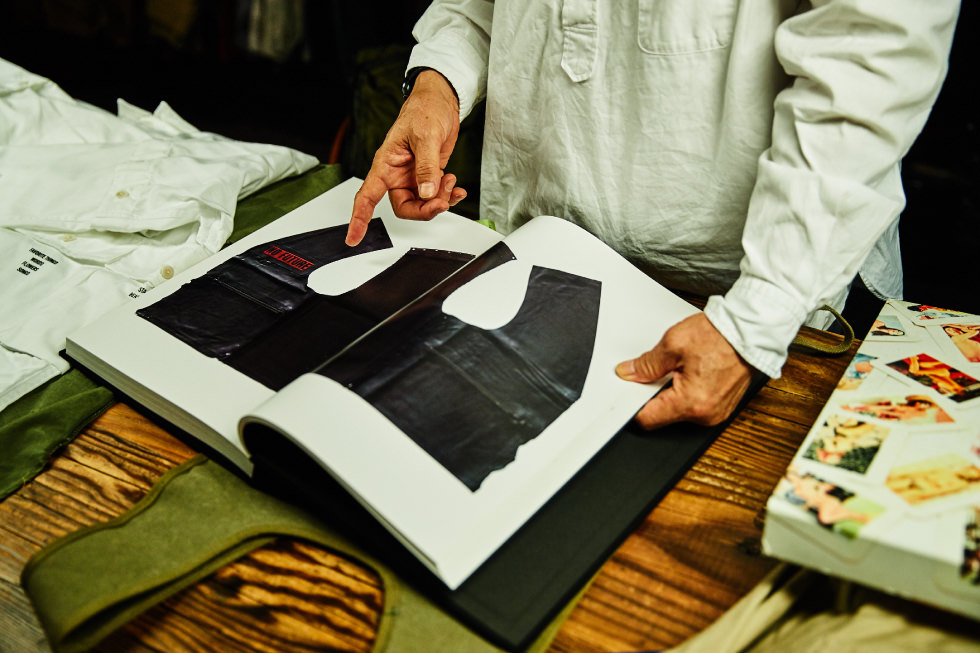
My basic idea of fashion came from
strangeness in clothing.
Backpacks became widely popular in the 1980s, but I couldn’t be bothered to take it off my shoulder whenever taking the contents out. Wearing a vest was way easier, so I used to stroll around the town in a fishing vest. When Columbia started to manufacture their black and red fishing vests in Korea in 1985 or 1986, clothing stores like PROPELLER carried the item and many people around me wore it. We even cut a super long shirt to an appropriate length and sewed it again to mix with the vest, because a fishing vest looked better with a pull-over shirt. You can’t layer it smartly without caring about the balance. Joseph Beuys is known as one of the famous figures who neatly sported a fishing vest. Andy Warhol were also clad in the vest during his trip to China, I think. We would immediately spot the item when looking at their photos because of a feeling of strangeness, wondering why they wear it. Such strangeness was, I think, the reason I first got interested in the garment. I don’t even do fishing, so I don’t really know what each pocket is designed for (laughs). Because of my lack of practical knowledge, however, I can enjoy the strangeness, I guess. In the 1980s, even SEDITIONARIES made a product based on fishing vests from Abercrombie & Fitch. I think it’s a very intelligent idea, because punk clothes are basically full of strangeness.
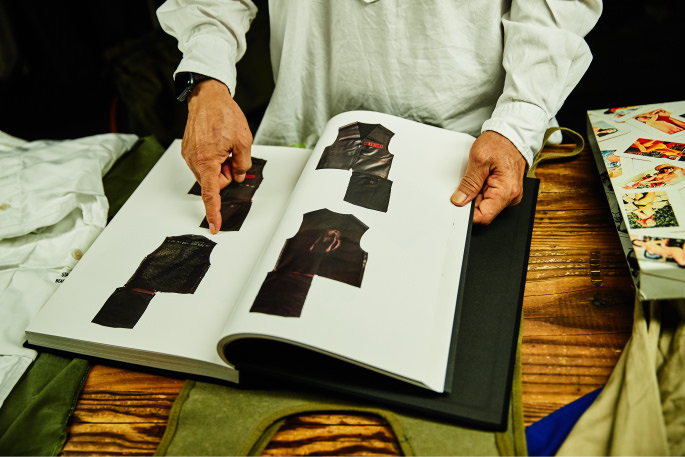
A visual book of SEDITIONARIES and its products.
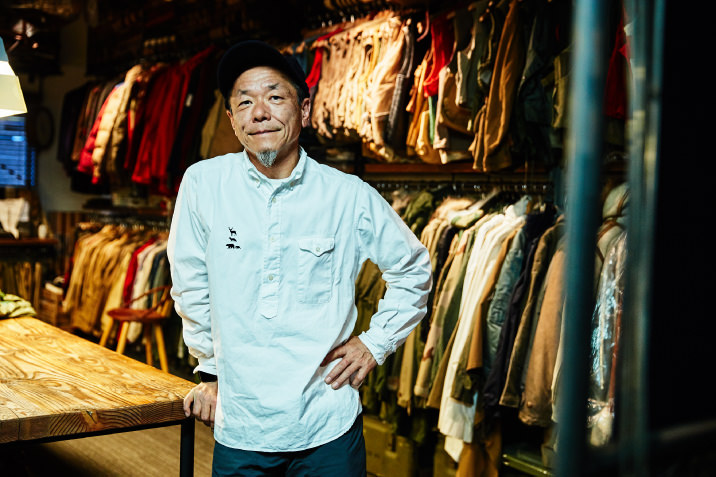
- Edit & Writing : Masayuki Ozawa
- Translation: Aya takatsu
- Photography : Dai Yamamoto
- Illustration : Naoki Shoji
- Design and Development : maam.inc
(Left) Cargo Vest /
Color : BEIGE, KHAKI, NAVY / Size : S, M, L, XL /
Price : ¥29,000+taxBUY
(Right) Cargo Shirt /
Color : OFF WHITE, MINT, BLUE / Size : S, M, L, XL /
Price : ¥32,000+taxBUY

The products shown in this article are
available at BEAMS PLUS stores.
BEAMS MEN SHIBUYA / BEAMS ROPPONGI HILLS /
BEAMS TSUJIDO / BEAMS KOBE / BEAMS HIROSHIMA
vol.15
American Suit
Hisao Saito
from TUBEvol.14
BACKPACK
Takao Fujimoto
from STANDARD SUPPLYvol.13
5 Pocket Denim Pants
Kenichi & Koji Shiotani
from WAREHOUSEvol.12
Luggage Wear
Setsumasa Kobayashi
from .....RESEARCHvol.11
Leather Wallet
Daisuke Motoike
from MOTOvol.10
Fatigue Pants
Daiki Suzuki
from ENGINEERED GARMENTSvol.09
Tie
Kenichi Kusano
from KENNETH FIELDvol.08
Tote Bag
Shinshu Kosuzume
from BRIEFINGvol.07
Coverall Jacket
Takeshi Ohfuchi
from Post O'Allsvol.06
Balmacaan Coat
Shinsuke Kojima
from KAPTAIN SUNSHINEvol.05
Western Shirt
Yutaka Goto
from REMI RELIEFvol.04
M-51
Kimitoshi Chida
from sage de cretvol.03
Sweat
Satoshi Suzuki
from LOOPWHEELERvol.02
Open Collar Shirt
Hirofumi Yamashita
from MOJITOvol.01
Blazer
Jack Carlson
from ROWING BLAZERS





































